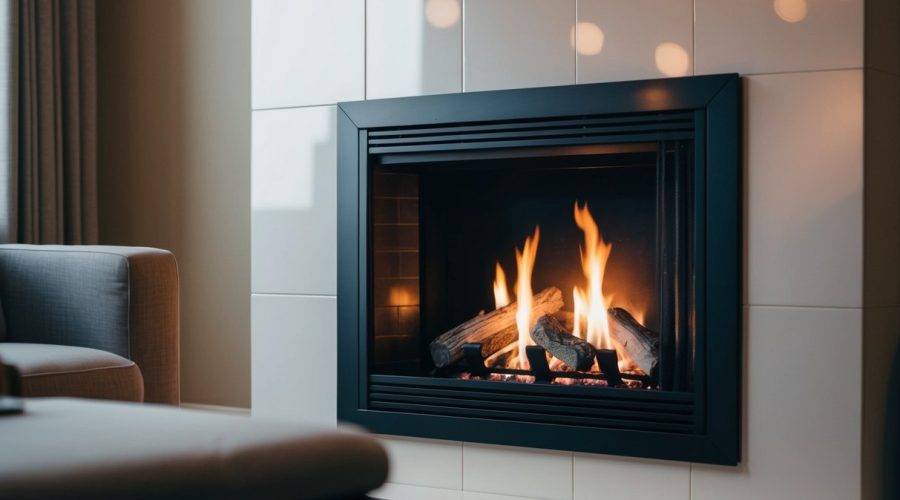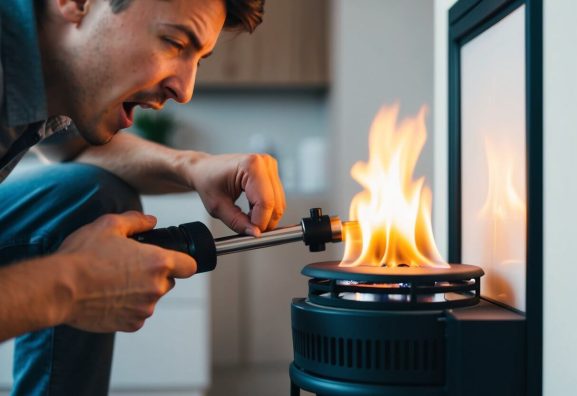Why Gas Fireplace Keeps Going Out: Common Causes and Solutions
Introduction
When the cozy flames of a gas fireplace unexpectedly cease, it can disrupt the warmth and ambiance of any room. A gas fireplace may keep going out due to issues with the pilot light, thermocouple, or even a blocked vent. Catching these problems early can save time and ensure a seamless experience while enjoying the fireplace.
Understanding the various components of a gas fireplace can aid in diagnosing and resolving these issues efficiently. Homeowners often encounter challenges with the thermostat or thermopile, which can lead to frequent shut-offs. Fortunately, many of these issues can be addressed with some basic troubleshooting skills or through regular maintenance and cleaning.
Ensuring the safe operation of a gas fireplace is crucial, as it involves potentially hazardous materials. By taking proactive steps in checking for defects and cleaning vital parts, one can enjoy a reliable and comforting warmth from the fireplace throughout the colder months.
Key Takeaways
- Check pilot light and thermocouple for common problems.
- Regular maintenance enhances reliability and safety.
- Advanced repairs may need professional assistance.
Understanding Your Gas Fireplace System
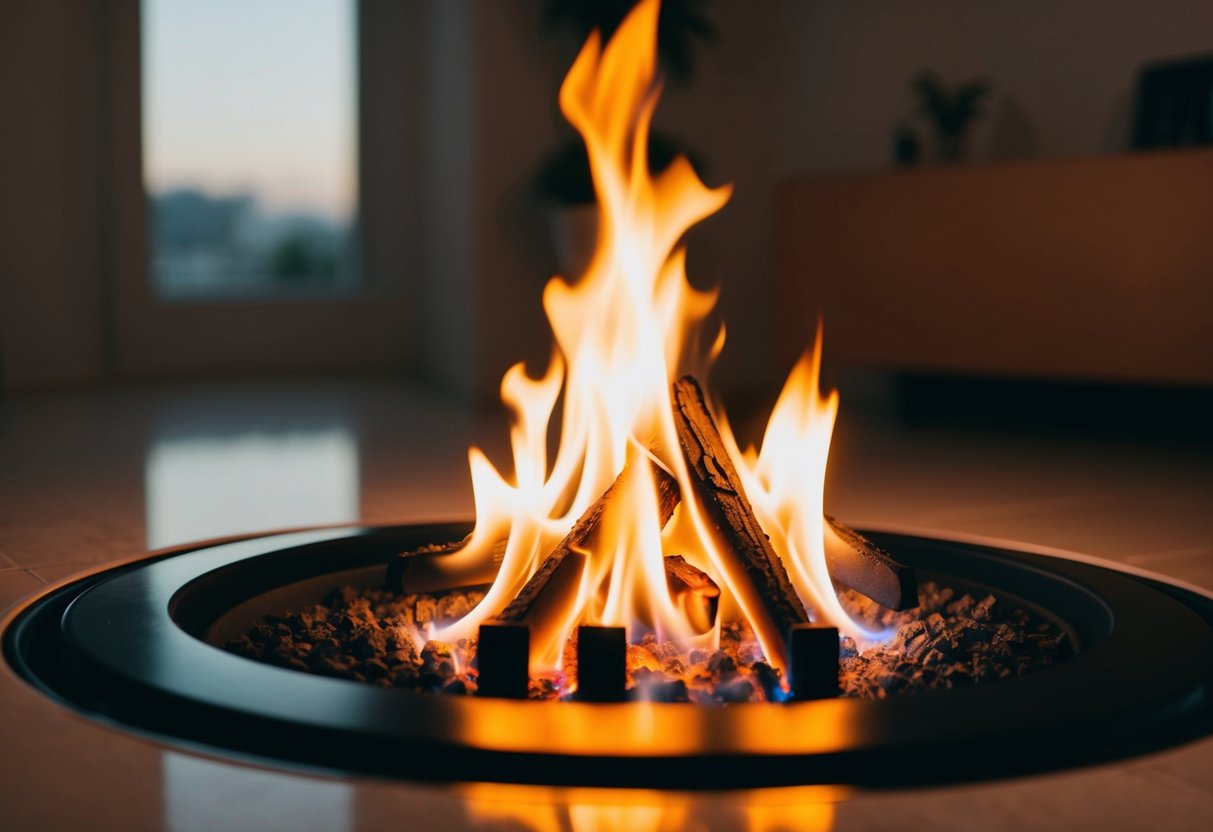
The proper functioning of a gas fireplace hinges on understanding its components and operational processes. Key elements include the ignition system, safety devices, and gas controls, all working in tandem to maintain a steady flame.
Components of a Gas Fireplace
A gas fireplace consists of several vital components. The thermocouple serves as a safety device, sensing heat from the pilot light and allowing gas flow. If the pilot light extinguishes, the thermocouple cuts off the gas supply. Another crucial component is the thermopile, generating electric current to ignite the burners.
The pilot light works with the thermocouple to sustain combustion. The gas valve regulates gas flow to the burners and pilot light. The ignition assembly, including elements like pilot burners and spark igniters, ensures the fireplace lights safely. The gas line feeds the system with natural gas or propane, enabling operation.
How a Gas Fireplace Operates
Gas fireplaces operate through a sequence of controlled events. Initially, the pilot light ignites the flame, heated by the thermocouple which allows gas to flow. The thermopile generates electricity to power the gas valve, opening it for burner gas flow, creating a larger flame.
Gas valves are precision components, managing both ignition and extinguishing flames. The pilot control ensures the pilot light remains lit, while the ignition assembly safely initiates the process. Overall, the system relies on precise calibration and maintenance. Any component malfunction can prevent the fireplace from operating, causing it to frequently shut off, emphasizing the need for regular checks and maintenance.
Common Issues and Troubleshooting
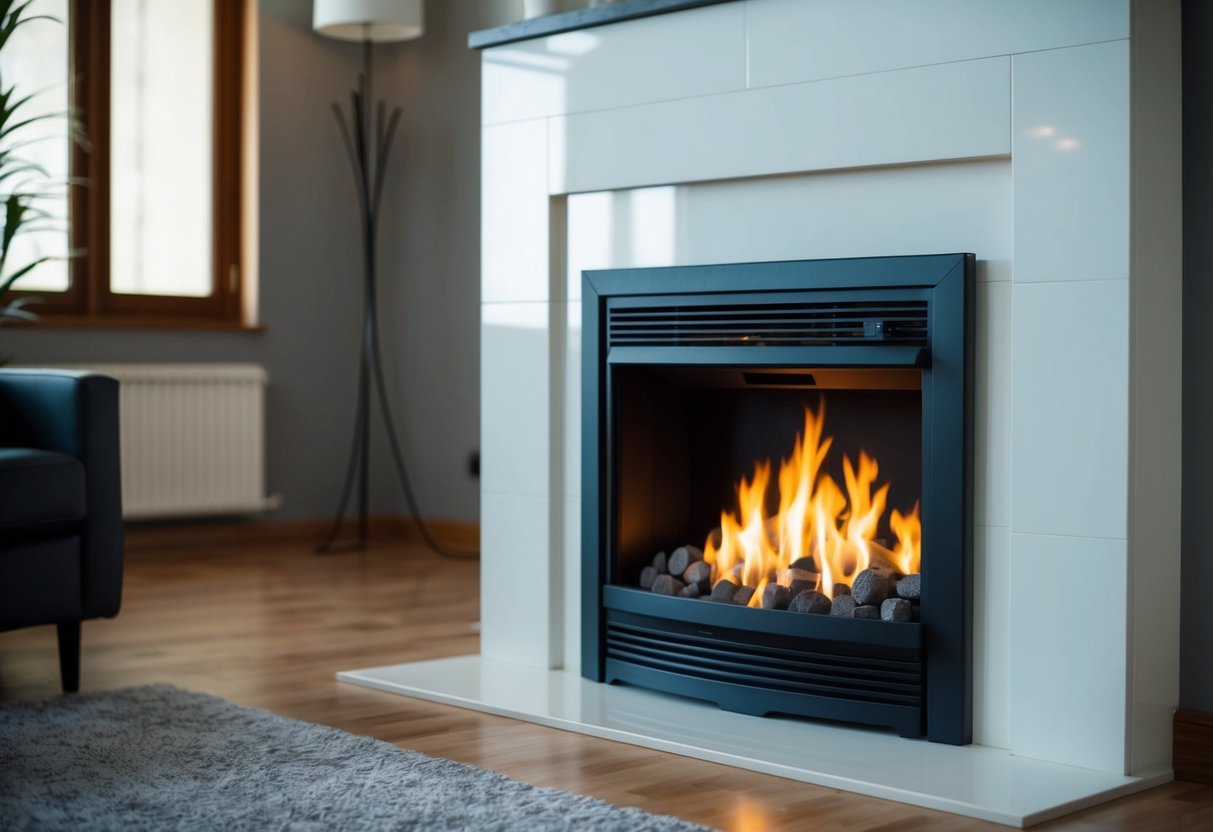
Gas fireplaces often face interruptions that can disrupt comfort. Understanding key issues such as thermocouple failures, pilot light problems, and gas flow complications can help maintain a steady flame.
Thermocouple and Thermopile Failures
A thermocouple is a safety device that senses the pilot light’s heat. If it fails, the gas valve will shut off, preventing ignition. A faulty thermocouple or thermopile might result from wear, positioning issues, or soot buildup.
Checking for proper alignment is essential. Ensure the thermocouple is close enough to the pilot flame. If it appears damaged or misaligned, repositioning or replacement is needed. Cleaning the thermocouple can also help, as debris and carbon buildup can affect its function.
Pilot Light Problems
The pilot light is crucial for starting the gas fireplace. Issues may arise from accumulation of dirt or a misaligned flame. These issues can extinguish the pilot light and stop the fireplace from functioning.
To address pilot light problems, cleaning is often necessary. Turn off the gas supply and use a wire brush or compressed air to clear away debris. Regular maintenance can prevent recurring issues. If the pilot light continues to go out despite cleaning, it might be a signal of a more significant problem that needs professional attention.
Gas Flow Complications
Gas flow complications can arise from blocked burner ports or faulty connections. These issues may prevent gas from reaching the necessary components, leading to a flame that flickers or goes out.
To resolve gas flow issues, it is important to inspect burner ports for blockages. Use a brush to remove obstructions and ensure smooth gas flow. Additionally, verify that all gas connections are secure and not leaking. Regular inspections by a qualified technician can maintain proper gas flow and prevent further complications.
Safety and Prevention
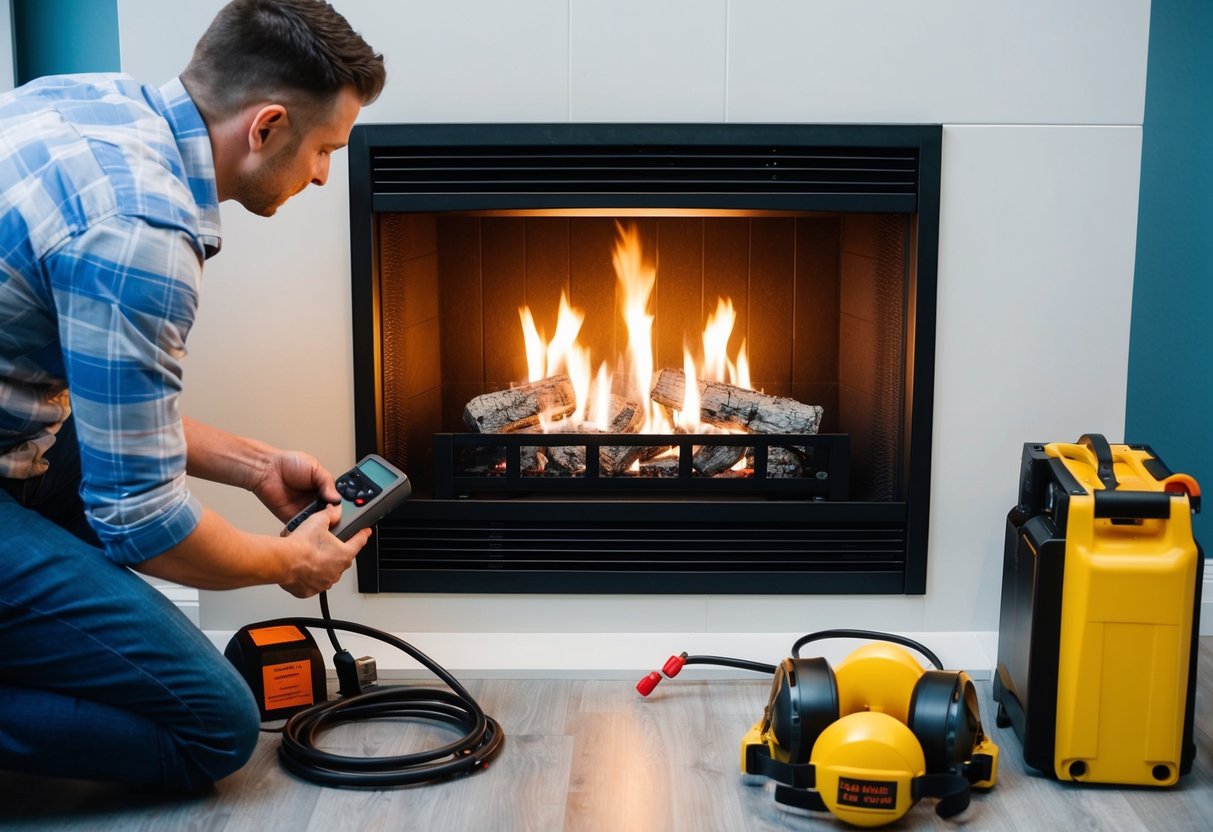
Ensuring a gas fireplace operates safely involves managing carbon monoxide risks and detecting gas leaks promptly. Essential safety devices and best practices can help prevent accidents.
Carbon Monoxide Risks
Carbon monoxide poisoning is a significant risk with gas fireplaces. This colorless, odorless gas can accumulate if a fireplace is malfunctioning or improperly installed. Carbon monoxide detectors are essential safety devices that alert occupants to dangerous levels of the gas.
Regular maintenance of the fireplace, including inspecting the oxygen depletion sensor, ensures adequate ventilation and proper operation. Warning signs of carbon monoxide include: headaches, dizziness, and nausea.
If symptoms occur, evacuate immediately and contact emergency services. Annual inspections by certified professionals help detect potential issues before they become hazardous.
Detecting and Handling Gas Leaks
Gas leaks pose another danger with gas fireplaces. The distinct sulfur-like odor of natural gas serves as a primary detection method. Immediate action is crucial—evacuate the area and avoid using electrical devices, which can ignite the gas.
Installing gas leak detectors adds an additional layer of safety. These devices alert occupants to leaks even if the odor isn’t detected. Periodic inspections ensure that connections, burners, and other components are secure and not subject to wear or damage.
Keeping ventilation pathways clear and performing routine checks can prevent leaks, ensuring safe and efficient operation of the gas fireplace.
Regular Maintenance and Cleaning
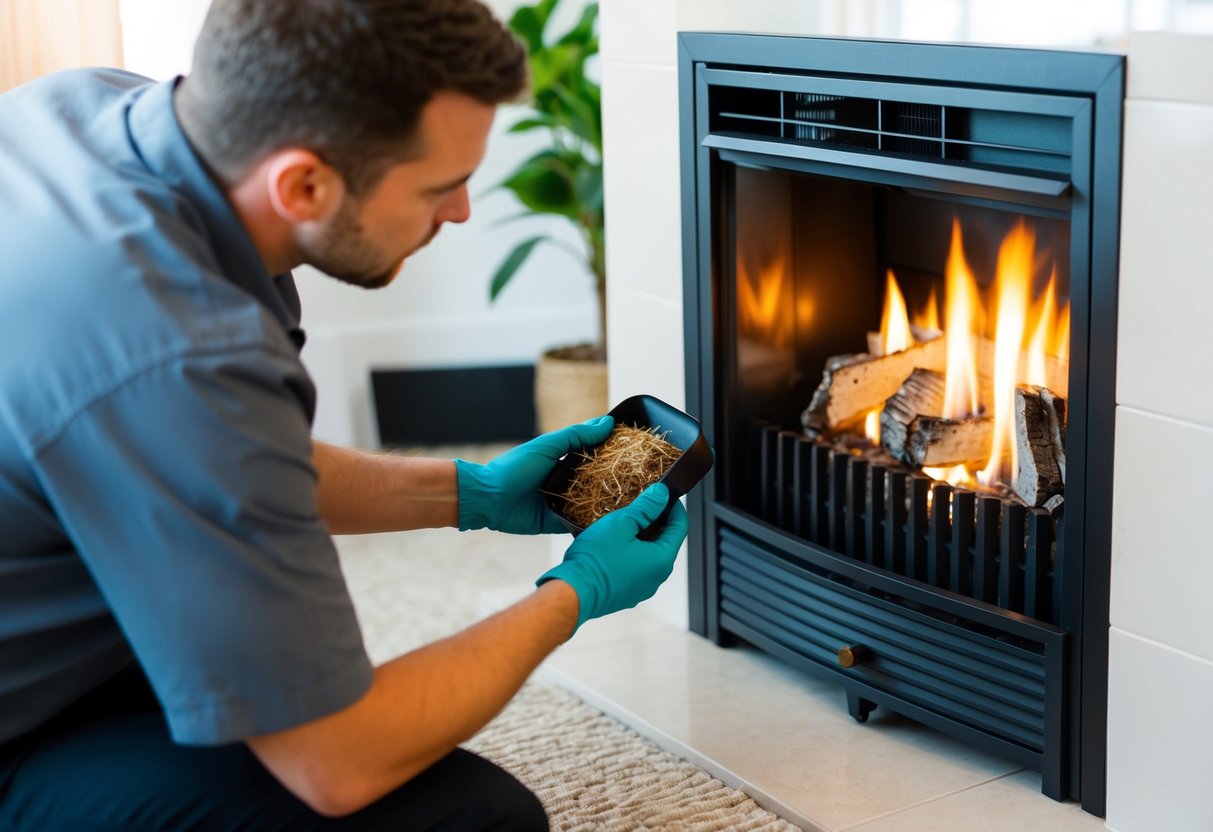
Proper maintenance and cleaning are essential for ensuring the efficient operation and longevity of a gas fireplace. Regular care helps prevent common issues like the fireplace going out unexpectedly.
Importance of Regular Cleaning
Regular cleaning of the gas fireplace is crucial to maintain its performance. Dust and other debris can accumulate around the pilot light and burner, leading to malfunctions. Cleaning tasks should include dusting the exterior, removing soot from the logs, and ensuring the glass door is clear of residue.
A wire brush can be used to clean carbon buildup around the pilot light. This helps in keeping the flame stable, preventing issues related to it going out. Ensuring that the drip loop in appliance wiring is free from moisture accumulation can also prevent electrical problems.
Professional Gas Fireplace Inspection
Engaging a fireplace professional for routine inspections can identify potential issues early. A professional will check the thermocouple and thermopile connections, ensuring they are operating correctly.
Regular inspections also include verifying the gas service pressure is adequate and consistent. Incorrect gas pressure can cause the fireplace to extinguish unexpectedly, and a professional can adjust or repair this. They also assess the condition of the chimney liner and vent system to avoid blockages that affect performance.
These professional evaluations ensure the fireplace operates safely and effectively, reducing the risk of unexpected shutdowns.
Advanced Repairs and Part Replacement
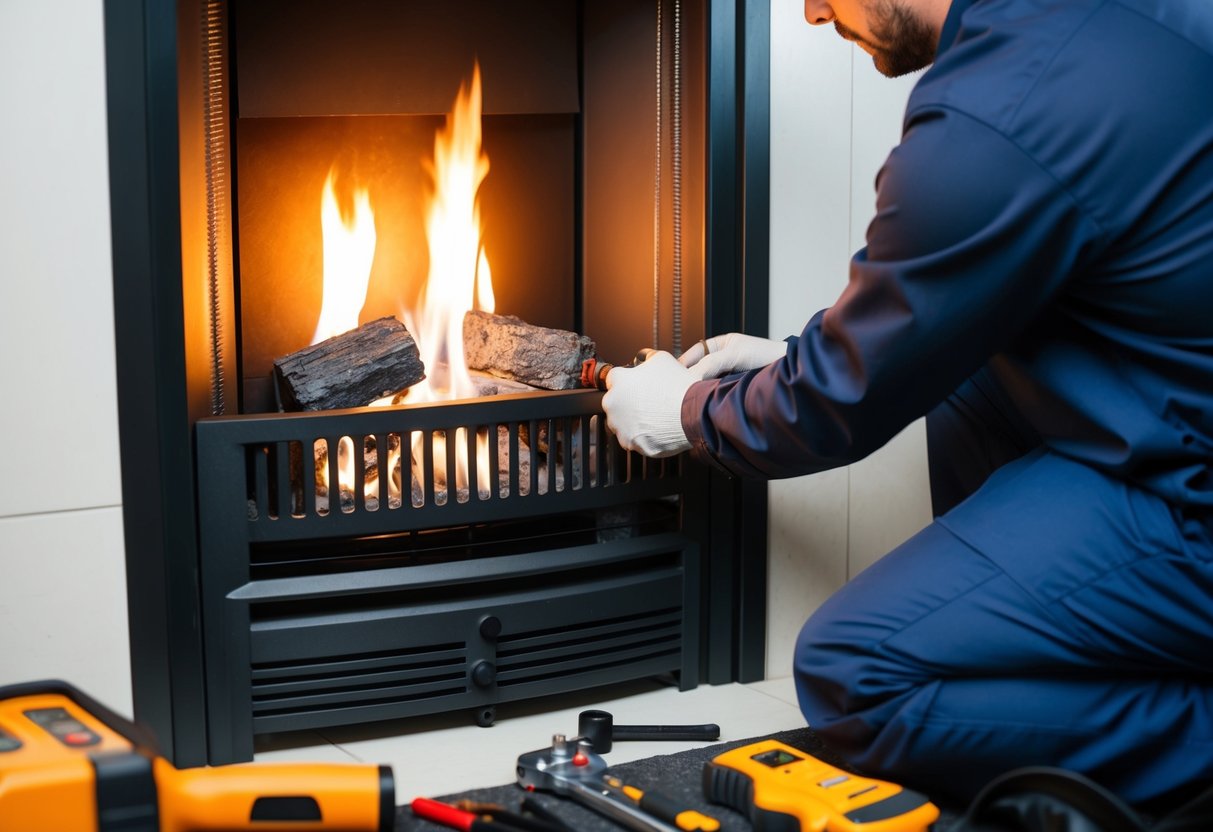
For advanced repairs, checking the thermostat is crucial. A malfunctioning thermostat can disrupt proper functioning. Verify its settings and ensure it communicates accurately with the fireplace.
The thermocouple and thermopile are vital parts ensuring the pilot light stays lit. If the pilot light frequently goes out, examine these components. A multimeter can help determine if replacement is necessary, checking for a reading of at least 300 millivolts.
Look into the oxypilot, which plays a role in ensuring safety by shutting off when oxygen levels are too low. If it’s faulty, the fireplace may turn off unexpectedly. Inspecting for damage or dirt can prevent this issue.
The circuit breaker should also be reviewed. A tripped breaker can cut power, stopping operation. Resetting it might resolve the problem, but persistent tripping may indicate a larger electrical issue.
While some issues, like repositioning a thermocouple, are manageable for a capable DIY enthusiast, professional help might be required for complex problems. Gas fireplace repair specialists are equipped to handle intricate repairs and replacements safely.
Regular maintenance and cleaning can significantly reduce the need for advanced repairs. Maintaining these components can prevent many common failures, ensuring the fireplace operates efficiently.
Frequently Asked Questions
Gas fireplaces going out can be due to various issues, including pilot light problems, thermocouple malfunctions, or blocked vents. It is important to address these common problems to ensure the safe and efficient functioning of your fireplace.
Why does my gas fireplace shut off after a few minutes?
A gas fireplace may shut off after a few minutes due to a faulty or dirty pilot light. The pilot light is essential for signaling the thermocouple to keep the gas line open. If it is malfunctioning, the fireplace will not maintain its operation.
How do you fix a gas fireplace that keeps going out?
Fixing a gas fireplace often involves cleaning or replacing key components. You may need to clean the pilot light or ensure the thermocouple is making proper contact. If issues persist, checking for obstructions in vents or consulting a professional can be beneficial.
What could cause a gas fireplace to suddenly go out?
Sudden issues may arise from problems with the gas supply, a malfunctioning thermocouple, or an obstructed vent. Ensuring that these components are functioning properly can help identify and resolve the issue promptly.
Why might a gas fireplace flicker on and off intermittently?
Intermittent flickering might be caused by a thermostat issue, loose wiring, or debris in the burner. Proper maintenance and occasional inspections can help prevent these interruptions and keep the fireplace working smoothly.
How can I determine if a faulty thermocouple is the reason my gas fireplace won’t stay lit?
A faulty thermocouple might be suspected if the pilot light frequently goes out. Testing the thermocouple with a multimeter for proper voltage can indicate if it is functioning. Repositioning may also be necessary if it doesn’t maintain constant contact with the pilot flame.
Is it normal for a gas fireplace to shut off if it gets too hot?
Some gas fireplaces have safety features that cause them to shut off if they detect overheating, preventing potential hazards. If this occurs frequently, it may indicate a need for adjustment or inspection to ensure the fireplace operates safely and efficiently.

